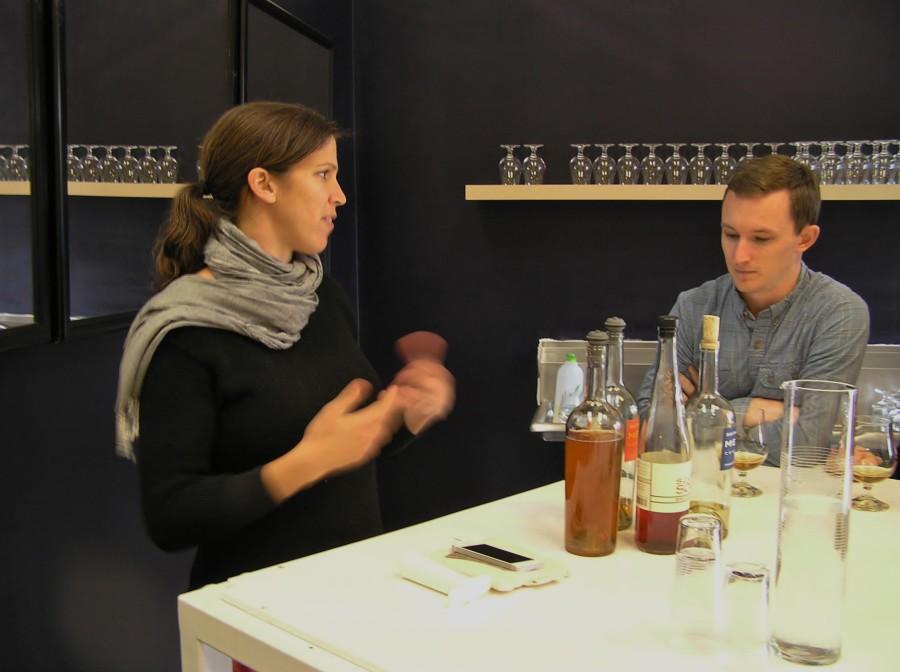People are buzzing about mead
Sarah Jones of San Francisco Mead Company guides taster Matt Langley through flight of mead samples.
September 4, 2014
There’s a new drink in town and it’s causing a buzz. Hipsters, foodies and history buffs are buzzing about this newly emerging beverage.
Offered as still or sparkling, sweet or dry, nuanced or bold, it appeals to disparate tastes and preferences. But it’s not wine, and it’s not beer. And it’s actually not so new.
It’s mead—an ancient concoction made simply from fermented honey and water, and believed to be the first alcoholic beverage ever created by humans. Also called honey wine, mead was guzzled by Vikings, toasted by kings and consumed by the masses throughout the Middle Ages. It began its gradual decline as beer and wine took to the forefront, and over time, mead was all but forgotten.
Until now, that is. With growing interest among consumers, beverage makers and trendsetters, mead is making a steady comeback here and across the nation. According to the American Mead Makers Association, the number of “meaderies” nationwide grew from 15 to 150 between 1992 to 2012.
In the Bay Area, mead is popping up at grocery stores, neighborhood bars and restaurants, and tasting rooms throughout the region. Today, there are about 20 meaderies across the state, and five in the Bay Area. Two of them are right here in the East Bay.
“There’s a growing awareness out there, and we’ve hit a sweet spot,” Dan Cook said, of the local mead market. Cook is mead maker and co-founder of the East Bay’s newest meadery, The Mead Kitchen. Along with co-founder Paul O’Leary, Cook opened the Berkeley based meadery in 2013.
Initially, their meads were offered on tap at local bars and restaurants. But word spread quickly and it wasn’t long before people began appearing at the tasting room door, asking to buy more.
“So within a week or so, we had stuff in bottles,” Cook recalled. Since then, they’ve seen a steady rise in sales and consumer interest.
But like the Mead Kitchen, most Bay Area meaderies are small, artisanal businesses with limited marketing funds to advertise their products. In some areas, mead awareness remains low.
Here on campus, interest is emerging.
“I haven’t used mead or honey wine in too much of my cooking, but I think it would go great with a lot of our food,” said Chris Draa, Chair of DVC’s Culinary Arts Department. Draa, who also teaches several baking and dessert courses, is aware of mead’s resurgence, but has not actively pursued it. Not yet anyway. That may change.
“I’d certainly like to get some samples to see how I can use it in my food, and how I can share with the students the difference in the making of mead as opposed to wine. The more we can share with our students, the better.”
Students too, are voicing interest as their awareness grows.
Kathy Bjerre, a student in the Culinary Arts program, says she first learned about mead in DVC’s Beer, Wine and Spirits class. It piqued her interest,
“I went online to see if there was somewhere I could taste it,” she said. She now plans to visit local tasting rooms.
Dori Taylor, a voice actor taking classes in DVC’s Theater Arts Department, first tasted mead years ago at a Renaissance Faire.
“I loved it,” she said. “It was sweet, but not too sweet. It was cold and refreshing.” But for many years, she says, the problem was a lack mead sellers beyond the Renaissance Faire.
That’s no longer the case, and Taylor hopes to sample some of the new, local brews soon. And she’ll have quite a variety to choose from.
While each meadery employs its own techniques, recipes and style, they all start with traditional mead, made by fermenting honey and water. Fruit and spices are often added to enhance flavors. By varying the proportions of honey and water, and the point at which fermentation is stopped, a wide variety of meads is produced, ranging from dry and light, to sweet and full bodied. If fermentation is left to continue in the bottle, a sparkling mead results, adding a bubbly option as well.
Yet to some mead virgins, a drink made from honey brings to mind a sweet, syrupy swill.
“I was a little nervous at first, and figured it would be really sweet, really thick, and not very enjoyable,” Mead Maker Cook said, about his initial expectation.
While meads of old may have been of the sweet, cloying variety, they’re far from it today. With modern technology and brewers’ creativity, contemporary mead makers have elevated the drink to a whole new level. As with grape wines, today’s meads reflect the terroir from which the honey is sourced, a range of sugar and alcohol levels brought about by fermentation, and a complementary relationship to food. And like grape wine, mead comes in many types.
More than 40 types in all, and many blends within each type. Most common are Melomel—containing fruit as well as honey, Cyser—a combination of mead and apple cider, and Metheglin—traditional honey mead with herbs or spices added. As today’s mead makers adapt their recipes and experiment with added ingredients, the array of meads continues to grow
And so does consumer demand.
“Americans are speaking out with their purchasing choices,” says a mead industry report published in the spring 2014 issue of American Mead Maker.
“They want to understand how their food is produced and where it’s sourced,” the report said. “They are curious, and value quality and flavor over mass production.”
And the data bears this out. Between 2012 and 2013 U.S. mead sales increased by 130 percent, making it the fastest-growing segment of the domestic alcoholic beverage market.
Mead experts cite a number of reasons for the groundswell of interest.
“For one, mead is joining the craft beverage movement which, particularly with beer, is growing by leaps and bounds.” said Amina Harris, Director of the U.C. Davis Honey and Pollination Center. In fact, nearly all of the local mead masters were beer brewers before turning to mead.
Harris also credits a resurgent “back-to-the land” mentality with advancing mead’s popularity. Its whole food ingredients and localized sourcing are the draw.
Oron Benary, mead maker and co-founder of the San Francisco Mead Company, agrees, especially when it comes to the Bay area. “People are a little more connected to their ecosystem here in San Francisco and Northern California,” he said.
The age-old drink also appeals to history buffs like Michael Faul, mead maker and founder of Rabbit’s Foot Meadery in Sunnyvale. A long-time student of medieval history, he first became aware of mead in his medieval readings. Now he’s one of the largest commercial producers in the nation, grossing more than a million dollars in sales last year, he said.
Also keen on mead is the ever-growing foodie culture, and its passionate quest for the latest in food and drink.
“And once people try it,” Benary said, “they love it.”
This was clearly evident among visitors at his San Francisco tasting room on a Saturday afternoon last spring.
Housed in a converted warehouse in the City’s Bayview district, the cool, airy meadery is fronted by a makeshift tasting room. Arriving guests were greeted by Benary’s wife and meadery co-owner Sarah Jones. Like Benary, Jones is tall, trim, and energetic. Moving deftly throughout the tasting area, she uncorked bottles, arranged glasses and greeted arriving guests.
Introducing two meads to be poured that day—California Gold made with honey from the Mendocino Forest, and Orange Blossom, created with honey from a Central Valley orange grove– Jones described how the specific honeys infuse each mead with the essence of terroir, that is, the flavors and aromas of the environment where nectar was gathered.
“In the California Gold, you get the expression of the plants and landscape of the Mendocino coast,” Jones said. “Whereas in the Orange Blossom, the bees are pollinating citrus trees, so you get a really distinct varietal.
“That’s the true terroir of California,” she told the visitors.
Nearly all were first-time mead tasters.
“I didn’t know what to expect,” said Nicole Roger, who arrived with date Matt Langley.
The young couple first learned about mead on an online website that suggested mead-tasting as a date destination.
“We had to look up what it was before we came,” she said. “I kept trying to Google—is it beer, is it wine? But we’re excited to try something new.”
“I really like it,” she said, after taking a few sips. “You can taste the honey, but it’s not overwhelming. It’s refreshing.”
Studying his first sample closely, Langley hesitated before sipping. “Is there any particular way to drink it?” he asked Jones.
“Just not through your nose,” she said with grin. “We don’t snort it.”
Jones went on to say that unlike the somewhat pretentious wine world, “with mead there’s not really that culture. People can come to it, and it’s just a little more accessible.”
After tasting both meads, Langley was surprised, and impressed. He’d expected something along the lines of a craft beer.
“But it’s not even close,” he said.
“It reminds me of white wine, but I like it better.
“It’s so smooth,” he said. “Smoother than wine.”
Several visitors likened the San Francisco Gold blend to sherry. Subtle, smooth, and nutty were common descriptors used.
Nearly all visitors purchased mead to enjoy later.
“I like it a lot,” said Oakland resident Courtney Kuhlman, a self-described beer enthusiast. “I thought it was going to be really strong like a liquor, but it surprisingly isn’t. It’s easy to drink. It’s good.”
Will they drink it again?
“Oh yeah,” she said. “We’re buying some, and will be drinking it with our friends. Then they can go out and buy some.”
If local mead makers have their way, that’s exactly what Kuhlman’s friends, and many others, will do.
And here in the Bay Area, they won’t have to go far to get more.
Note: Two other meaderies in the Bay Area are Heidrun Meadery in Pt. Reyes Station and Enat Winery in Oakland.







































































